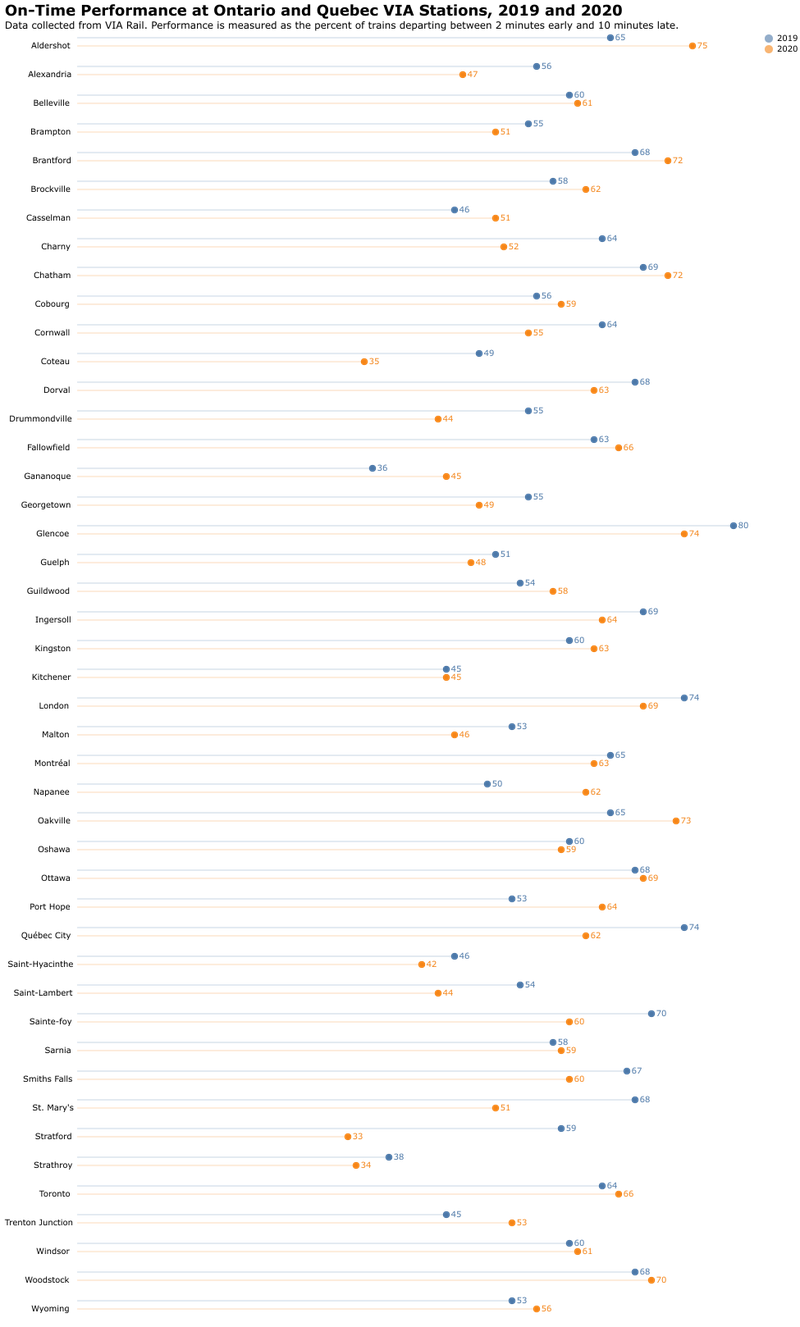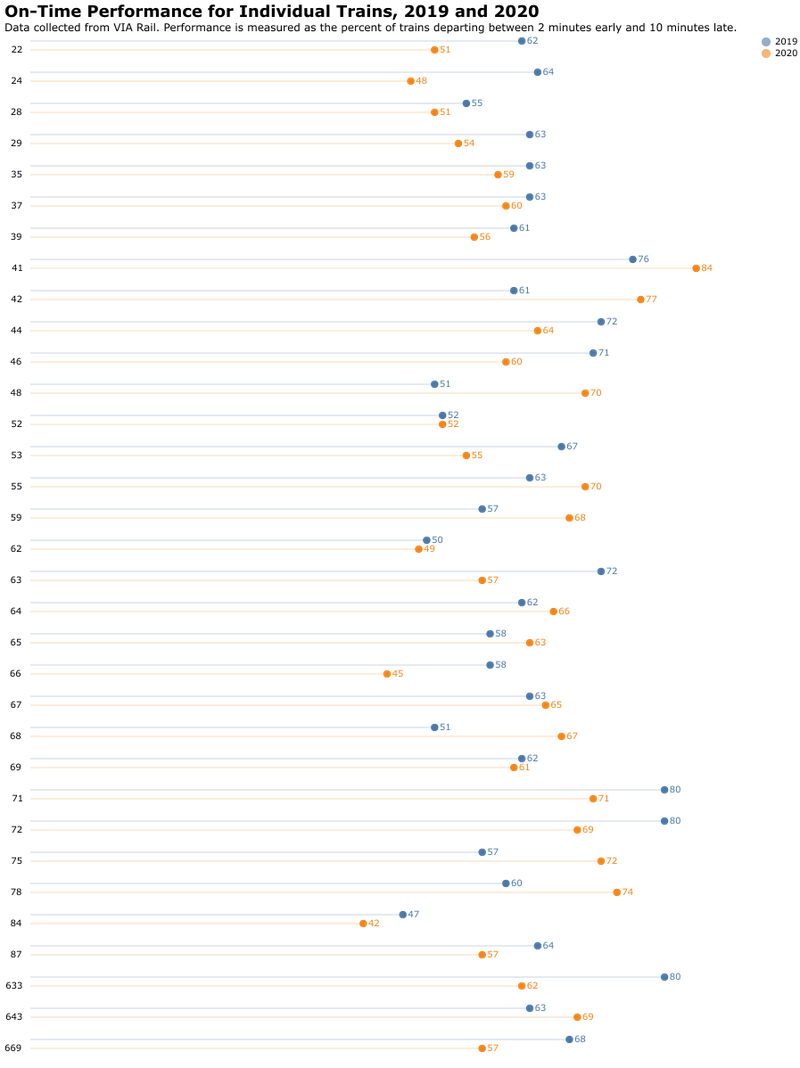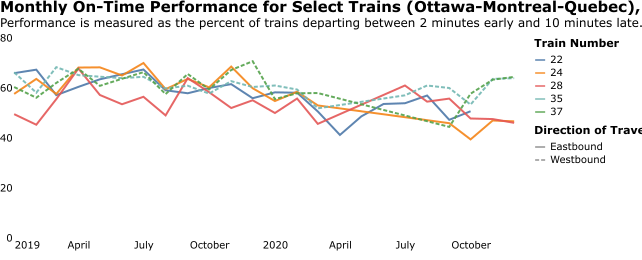Feb. 1, 2021
VIA Reliability, 2019-2020
Did the pandemic affect VIA's reliability? All signs point to no.
I've been archiving data that VIA publishes on their trains' real and scheduled arrivals and departures in Ontario and Quebec since early 2018, in an effort to learn and monitor trends in intercity passenger rail performance in Canada. I used the data for some research on shared corridors and potential impacts of improvements.
I was curious if 2020 (specifically the Coronavirus pandemic) changed much for VIA's reliability. With ridership way down due to the pandemic and VIA running fewer trains (take a look at their temporary schedule), I thought it would be interesting to see how and where VIA's on-time performance changed.

Of the 91,489 stops I recorded for these trains in 2019, 62% of them departed (or arrived at terminals) between 2 minutes early and 10 minutes late. 2020 saw far fewer trains and slightly worse on-time performance, with 60% of the 70,133 trains departing on time. Note that I decided to look at data only for trains which continued running later than June 2020 to keep some consistency between years.
Station-Level Performance
With a small network-wide change not giving us an immediate and satisfying answer, let's look at specific stations, and see if there's a pattern:

There are some clear winners and losers: Aldershot, Oakville, Port Hope, Napanee, Gananoque, and Trenton Junction saw gains of close to 10% in on-time performance. Some of these (Aldershot and Oakville) may be a result of decreased GO service, meaning less chance of conflicts between passenger trains on the Lakeshore West corridor. Others have a less clear explanation. Big drops in reliability occurred for St. Mary's and Stratford.
Two corridors that seemed to fare worse in 2020 are the Kitchener corridor (St. Mary's and Stratford on the west end of the corridor) and the Ottawa/Montreal/Sainte-Foy/Quebec corridor (Alexandria, Cornwall, Coteau, Drummondville, Stainte-Foy, Quebec City). The Kitchener corridor east of Kitchener has been long plagued with slow orders, conflicts with freight, and deteriorating track (VIA seems unwilling to adjust their schedule to compensate). As we will see below (spoiler alert!), the Ottawa-Montreal-Quebec decreases may be for similar reasons.
Performance by Trains
We can turn to specific train numbers for more detail on specific corridors and times of day. VIA organizes their train numbers so that eastbound trains are even, and westbound trains are odd. Furthermore, decades of numbers often correspond to similar or the same corridors (600-series trains share the last 2 digits of their non-express counterpart). Here's what 2019 and 2020 looked like for individual runs:

Two corridors stand out again, the Ottawa-Montreal-Quebec corridor (Trains 22, 24, 28, 35 and 37) and the Kitchener corridor (Trains 84 and 87). In the former case, eastbound trains are the big contributors to the drop in reliability, while in Kitchener it's relatively evenly split. There are also time-of-day differences that appear: Trains 75 and 78 running Toronto-London-Windsor and back in the evening saw big reliability boosts, while Trains 71 and 72 (which do the same trip but in the morning) saw reliability drop substantially.
Monthly On-Time Performance
Were these performance drops the result of the start of the pandemic? Let's take a look at monthly performance for trains in the Ottawa-Montreal-Quebec and Toronto-London-Windsor routes:


The Ottawa-Montreal-Quebec route seems to have steady decline in performance through 2019 and 2020. This suggests other factors such as track deterioration and slow orders may be the issue. VIA has been waiting for their high-frequency rail plan to gain funding, which would presumably be put into improving the existing Ottawa-Montreal connection as well as building new ones from Montreal to Quebec.
Changes in performance are a little more sporadic on the Toronto-London-Windsor line. Trains 72 and 78 had big drops in performance during the summer of 2020; this is likely the contributing factor to the performance decline in the service overall. Interestingly, the morning pair of trains (75 and 78) started worse than the evening ones (71 and 72), but the two pairs seem to have started converging starting in late 2019, when the morning pair of trains saw improved performance.
Freight Movements
Lastly, I wanted to see if there had been major changes in freight traffic that might be contributing to places where corridors are shared. Unfortunately data is only available from Statistics Canada on a Canada-wide basis, but in any cases it doesn't appear there was a large increase in freight movements in 2020:

Freight traffic would not have affected VIA's performance on the Ottawa-Montreal link anyway, since it's already VIA-dedicated track.
Final Thoughts
Ultimately, the reliability of VIA's trains does not seem to have been substantially impacted by the Coronavirus. This points to a larger problem though: Much of their reliability issues comes from conflicts with freight traffic and aging fleets. This is emphasized in a quote from VIA's 2016-2020 corporate plan summary:
VIA Rail can no longer function within its existing framework. The current relationship with freight rail operators no longer works as VIA Rail cannot control the fundamentals required to operate efficiently in a commercial manner in a competitive environment. No intercity passenger rail carrier among the G7 countries (and almost none in the G20), is burdened with the constraints and barriers faced by VIA Rail and as such, VIA Rail cannot thrive and bring the socio-economic benefits associated with passenger rail travel gained elsewhere in the world to Canada and to Canadians.
Funding can fix broken infrastructure and replace aging fleets, but only policy changes will fix their conflicts with freight rail.